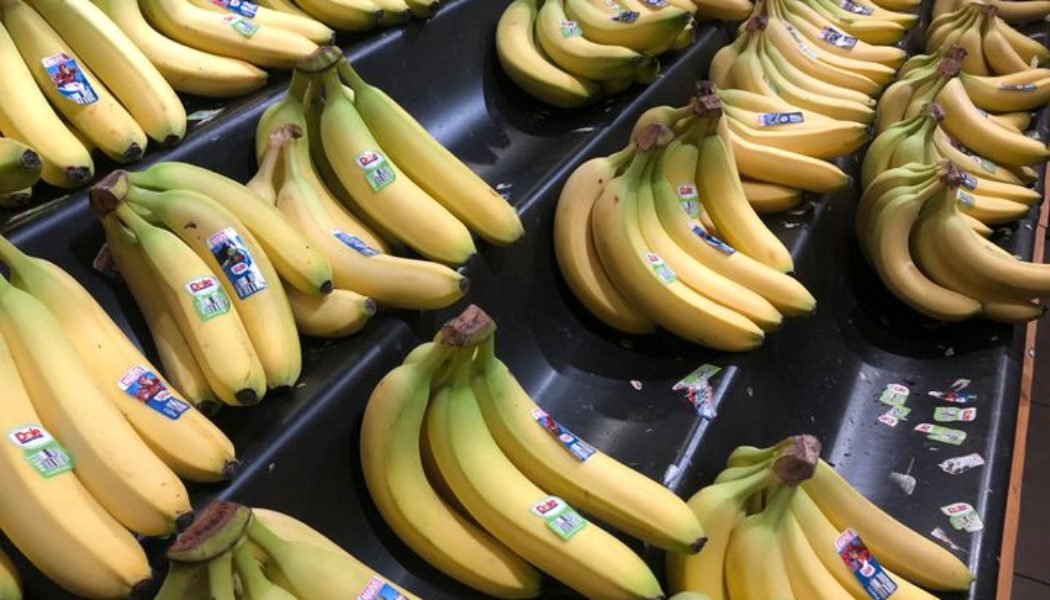Ever wonder why a pear or bell pepper has an individual sticker? If you assumed the sole purpose is for the price scanner at the grocery store checkout, you’d be wrong.
There’s more than meets the eye. Produce stickers, referred to as PLU (price look-up), are important for the supply chain, from packaging and shipping to delivery and selling at the grocery store.
Advertisement
They also can be helpful for consumers. But you’ll need to know how to decode the digits to understand what the numbers mean.
Why does produce have PLUs?
The International Federation of Produce Standards, a global industry group, regulates and assigns PLU codes. And there’s an approval process that occurs before produce gets a PLU.
“The International Federation for Produce Standards assigns PLUs based on applicants meeting requirements and it receiving enough support from a variety of produce associations around the globe,” explained Brianna Shales, the marketing director at Stemilt Growers who also serves on the Produce Identification Committee for the International Fresh Produce Association.
These labels are a way to identify produce, keep track of inventory, and can distinguish the variety as well as the country of origin.
Advertisement
“Stickers are used on all types of fruits and vegetables for identification purposes,” said Jeff Salchenberg, the produce program and category manager for New Seasons Market. “They are useful at various points during the supply chain.”
How does it help the shippers and packers?
“As the packer-shipper, it helps us deliver the right product to the customer, and ensure that they are equipped to run it through their inventory and sales systems,” Shales said.
If something goes amiss or there is a recall, these labels make a zucchini or potato more traceable.
“The origin and lot code are food safety tools that enable sellers to track down the produce included in a given batch or shipment, in case of a recall,” said Annie Myers, the owner of Myers Produce, a woman-owned regional trucking company.
How do stickers help grocery stores?
When truckloads of fruit and vegetables arrive at the grocery store, PLUs provide information on the variety, price and point of origin.
Advertisement
“They help cashiers and self-checkout machines accurately identify the items by the number on the sticker that is assigned to the particular fruit or vegetable,” Salchenberg explained.
Take, for example, apples. A grocery store may have many red apple varieties for sale — Fuji, Honeycrisp, Gala, McIntosh, Pink Lady, Red Delicious. To the untrained eye, they may be hard to distinguish (especially between organic and conventional!), but the digits will help.
“They are important for identifying types and varieties of produce, and helping sell fruits and vegetables for the correct price,” Shales said.

UCG via Getty Images
How can you tell if it’s organic or conventional?
Ready to decipher the produce sticker on your avocados and mangoes? The amount of digits isn’t random; they give you a clue as to how it was grown.
Advertisement
“PLUs are either four or five digits,” Salchenberg said. “A four-digit PLU means that the item is conventionally grown, and five-digit PLUs beginning with the number 9 represent a certified organic item.”
The numbers are used globally. So, no matter where you are in the world, you can figure out what the code means.
“So, 4011 is a yellow Cavendish banana from coast-to-coast,” Salchenberg said.
Five-digit codes beginning with the number 8 once were intended for GMO produce items, which are genetically modified, but were never used at retail because so few growers opted to voluntarily label GMO produce items.
“The leading 8 now has no significance to growing type,” Shales said.
Why doesn’t all produce have a sticker?
There are some circumstances where a piece of fruit may be without a sticker. Whether an item receives one has to do with where and how it’s packaged.
“Fruits and vegetables can be field packed, or packed in a production facility,” Shales said. “At Stemilt, we place a PLU sticker on the packing line right after it goes through a sizing and sorting machine that uses images to electronically size and sort the fruit based on its qualities.”
Advertisement
Bagged or boxed produce won’t have a sticker, because it’s sold differently and usually has its own barcode. The size of the produce also influences whether it gets its own PLU.
“Large-ish items with hearty skins are the most common, like eggplant and sweet potatoes, but even fragile items like tomatoes often get a sticker, whenever they are sold individually and not packaged in a bag, box, clamshell or other container,” Myers said.
If you’ve noticed that fruit seems to a sticker more often than vegetables, you’re right.
“PLU stickers are more common on fruit than vegetables or herbs,” Shales said. Sometimes the sticker goes on the wrapping, often with herbs. “Cilantro, for instance, has a PLU code as an identifier for grocery checkout, but it is wrapped on the bundle because a sticker wouldn’t adhere to a bundle of cilantro,” Shales said.
In Europe, you’ll likely see fewer PLUs, since a lot of produce is prepackaged. “Apples in many European countries aren’t sold bulk or individually, so they won’t have a sticker. They are sold in packages,” Shales said.
“Don’t be concerned if unpackaged produce does NOT have a sticker,” Myers said. “There are very few small-scale growers who sticker their produce — just think about the labor involved in hand-applying a sticker to every tomato coming out of the field.”
Advertisement
Are stickers safe to eat?
Produce stickers aren’t intended to be eaten. But if you accidentally swallow one while biting into a juicy peach, there’s no need to panic.
“The stickers themselves are not toxic and neither is the adhesive used to apply them to the produce,” Salchenberg said. “If the stickers are accidentally ingested, there should be no cause for concern.”
It’s best to remove the stickers and rinse produce before eating, Salchenberg advised.
And when you peel off these stickers, place them in the trash can. The labels are not biodegradable and will not break down in your compost pile or compost bin.









